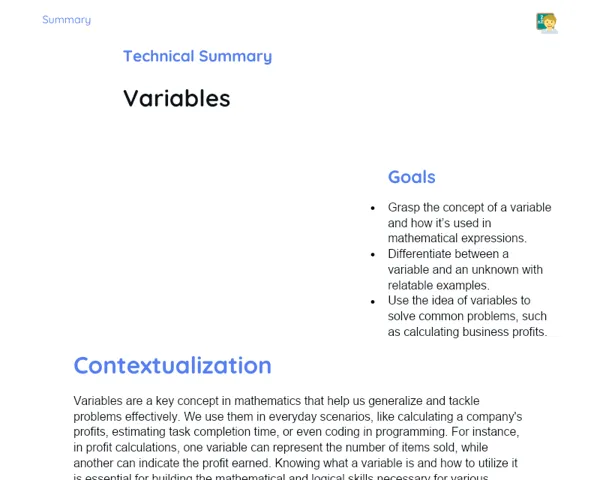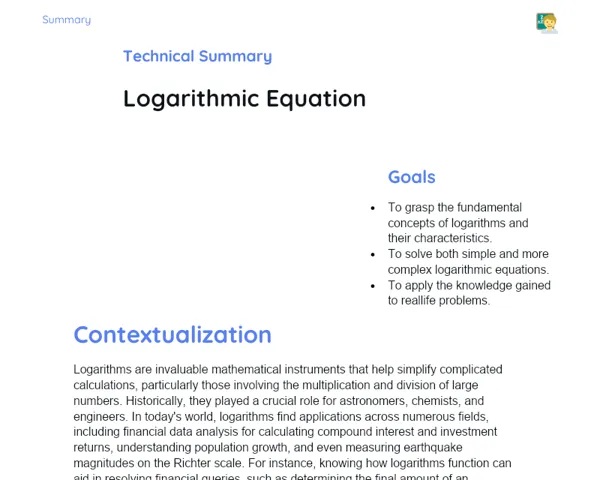Socioemotional Summary Conclusion
Goals
1. Understand the significance of trigonometric functions (sine, cosine, and tangent) in solving equations.
2. Identify and implement the steps for effectively tackling trigonometric equations.
3. Cultivate the ability to recognise and manage emotions when confronted with challenging mathematics problems.
Contextualization
Did you know that trigonometry is part of many everyday activities? From engineering bridges to producing visual effects in films, trigonometric equations allow us to understand and represent the world around us. Additionally, mastering these equations can equip you with vital life skills like resilience and self-discipline! 🚀
Exercising Your Knowledge
Basic Trigonometric Functions
Basic trigonometric functions—sine, cosine, and tangent—are key to grasping angular relationships and proportions within a right triangle. Let’s investigate how these functions are defined and where we can apply them in real life.
-
Sine (sin): Represented as the ratio of the length of the side opposite the angle to the hypotenuse. For example, in a triangle with a 30° angle, the sine of 30° equals 0.5.
-
Cosine (cos): Denotes the ratio of the adjacent side's length to the hypotenuse. For instance, in a triangle with a 60° angle, the cosine of 60° is also 0.5.
-
Tangent (tan): Expressed as the ratio of the opposite side's length to the adjacent side. For example, in a triangle with a 45° angle, the tangent of 45° equals 1.
Periodicity of Trigonometric Functions
Trigonometric functions have a periodic nature, meaning their values recur at regular intervals. Understanding periodicity is essential for tackling trigonometric equations, as it helps us uncover all potential solutions.
-
Sine and Cosine: Both have a period of 2π, which means sin(x) = sin(x + 2kπ) and cos(x) = cos(x + 2kπ), where k is an integer.
-
Tangent: Has a period of π, meaning tan(x) = tan(x + kπ).
-
Graphs: Visualising the graphs of trigonometric functions enhances our understanding of their periodicity and how values cycle.
Trigonometric Identities
Trigonometric identities are equations involving trigonometric functions valid for all angle values. They are powerful tools for simplifying and solving trigonometric equations.
-
Fundamental Identity: sin²(x) + cos²(x) = 1. This identity serves as the foundation for many others and is pivotal for simplifying equations.
-
Tangent in Terms of Sine and Cosine: tan(x) = sin(x)/cos(x). This identity allows us to transform tangents into sines and cosines.
-
Sum and Difference Identities: Offer formulas for sines, cosines, and tangents of the sum and difference of two angles, such as sin(a ± b) = sin(a)cos(b) ± cos(a)sin(b).
Key Terms
-
Trigonometric Equations: Equations that involve trigonometric functions like sine, cosine, and tangent.
-
Sine (sin): A trigonometric function that connects the angle of a right triangle to the ratio between the opposite side and the hypotenuse.
-
Cosine (cos): A trigonometric function indicating the relationship between the angle of a right triangle and the ratio of the adjacent side to the hypotenuse.
-
Tangent (tan): A trigonometric function that relates the angle of a right triangle to the ratio between the opposite side and the adjacent side.
-
Periodicity: A characteristic of trigonometric functions where their values repeat at set intervals.
-
Trigonometric Identities: Equations that hold true for all angle values and involve trigonometric functions.
For Reflection
-
How can identifying and naming your emotions enhance your problem-solving skills when facing complex challenges like trigonometric equations?
-
Think of a scenario outside of maths where periodicity (regular repetition) can be observed. How does this illustrate the importance of spotting patterns in daily life?
-
Reflect on a moment of frustration while collaborating in a group. What socio-emotional techniques could you employ to improve communication and collectively resolve the issue?
Important Conclusions
-
Trigonometric functions—sine, cosine, and tangent—are vital for resolving equations and comprehending the relationship between angles and sides of a triangle.
-
Understanding the periodicity of trigonometric functions is key to discovering all possible solutions to equations.
-
Trigonometric identities are instrumental in simplifying and solving intricate equations, providing valuable resources in mathematics.
-
Learning to tackle trigonometric equations also fosters socio-emotional skills like self-awareness, resilience, and effective communication within groups.
Impacts on Society
Trigonometric equations significantly influence various aspects of society, from engineering to technology. For instance, in civil engineering, trigonometry is employed to craft safe and stable structures, such as bridges and buildings. Moreover, in fields like physics and astronomy, trigonometric equations assist in modelling and understanding natural events, like planetary movements and sound propagation. This knowledge enriches our quality of life and broadens our grasp of the universe.
In students’ daily lives, the applications of trigonometry can be seen in less apparent yet impactful ways. This includes graphics design in video games, visual effects in movies, and even in managing financial calculations. Conquering challenges associated with trigonometric equations can boost students' self-esteem and sense of achievement, thereby enhancing their problem-solving skills and resilience.
Dealing with Emotions
Let’s try out the RULER method at home to help manage your emotions while studying trigonometric equations. First, Recognise your emotions when facing a problem: are you feeling frustrated, anxious, or maybe even excited? Understand what triggers these feelings. For instance, frustration could stem from not grasping a concept, while satisfaction may arise after solving a tough problem. Label these emotions accurately. Express your emotions in a constructive way, perhaps by discussing them with a friend or jotting down your thoughts in a journal. Lastly, Regulate your emotions by taking a break to breathe, unwind, and organise your thoughts before continuing with your studies.
Study Tips
-
Practice solving trigonometric equations daily to strengthen your understanding and confidence.
-
Utilise graphs and visual aids to depict trigonometric functions and their solutions. This enhances comprehension of periodicity and identities.
-
Form study groups with classmates to collaboratively solve problems, sharing strategies and insights.



